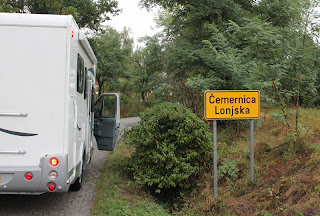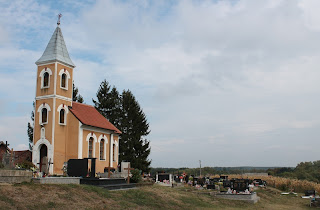Visiting the capital of Croatia (part of the former Yugoslavia) had a specific purpose with some objectives; herewith a short introduction to the story.
On 4 May 1945, a B26 Martin Marauder (fast medium bomber) from 25 Squadron South African Air Force (SAAF) with 7 aircrew on board, was shot down by German anti-aircraft (AA) guns to the east of Zagreb. The co-pilot was Lt MC Bekker, an uncle of mine. This was the last mission of the Squadron in WW2, flown three days before the end of the war. Their target was the Zagreb-Dugo Selo railway line east of Zagreb and their mission was flown in support of Marshall Tito's Yugoslav Partisans, who were battling with retreating German forces on and near this railway line.
All seven crew members died, two were buried near the wreckage and the remaining five in a nearby churchyard.
No one from my family has ever visited the area, access to the area only became possible once Croatia became an independent country, after the break up of Yugoslavia and resulting civil wars in the Balkan region. Visiting the area became a certain destination once plans for this 'European Adventure' was in place.
Details and relevant information pertaining to this mission have been obtained from Lt Bekker's logbook and from the archives of the SAAF.
B26 Martin Marauder
I had three objectives in mind:-
- finding the location of the German AA position
- seeing the area where the aircraft went down
- finding the churchyard where five of the crew were buried
We left our overnight camperstop in rainy weather for the Dugo Selo area using our SatNav programmed with the map grid reference of the AA gun position. This took us to the sprawling village of Tedrovec near Dugo Selo. Following the road into the village we came across a memorial.
Memorial to Yugoslav partisans
This was a memorial to Yugoslav partisans who fought and died during hostilities in the area. I also spoke to a man from a nearby house, in German because he spoke no English, who took and showed me the remains of what seems to be fortified positions / bunkers near the railway line. He also said that the rail bridge nearby was rebuilt in the early 1950's and that more of the 'bunkers' were visible when he was a child in the early 1970's. The area is now overgrown in grass.
Train crossing the bridge with bunker remains left centre
I drove further into Tedrovec and came across more remains of fortified positions which showed a collapsed roof and strengthened walls. There was also a staircase leading into the position and judging by the size of it, it may have been an accommodation area for German soldiers.
More remains of some fortified position
We left the area of Tedrovec late afternoon and to me the following was clear, based on my own observations and the hour long conversation I had with a resident who has been there since the 1960's.
- the railway line was important to the Germans, to the extent that permanent fortified positions were built protected by AA gun positions
- a major skirmish occurred here, to the extent that a memorial to Yugoslav partisans was erected
- the target was one of significant importance to the Yugoslav partisans and their fight against the retreating Germans, in that the mission was sanctioned so near to the end of hostilities
My next place of visit was the area where the aircraft went down. According to the records it appeared as if a controlled emergency landing was attempted with the stricken Marauder in a field about two miles north of the AA position. This was obviously unsuccessful and all seven crew members perished.
Area where the aircraft went down
Field corresponding to reference
I drove to the village nearest the given map grid reference and parked our motorhome near some buildings. I walked some distance into the fields, for my own sake and to pay respects.
They shall grow not old, as we that are left grow old:
Age shall not weary them, nor the years condemn.
At the going down of the sun and in the morning,
We will remember them
I also spoke to workers nearby who in turn flagged down a passing car with someone they knew. The girl spoke English and suggested that I visit the 'Klostar Ivanic', a church in the nearby town of Ivanic Grad and speak to someone in authority there regarding my enquiries.
This I did and promptly went knocking on the door of what turned out to be a Franciscan monastic order. I was cordially asked by a Nun who spoke German, to sit down whilst she calls someone to assist me. I duly had a conversation in German with a Father of the monastry.
I put to him all relevant details and asked if indeed there was a churchyard near the town of Beslinec, as given in the SAAF archives. He confirmed that and directed me on how to get there, only some 5 miles to the north of Ivanic Grad. He said it was a very small churchyard and that the church is not readily visible from the main road. He also said that if I needed more details, if this exists and if it can be found, regarding the burial of the crew, I could come back the Monday (this being a Saturday) and the office could help.
We travelled the few miles but somewhere I must have missed a turning and decided to turn around and start looking anew, when a car pulled up behind us and a man got out. In fluent English he asked if he could help, saying that he saw this British registered motorhome passing by obviously looking for something. I gave him some brief details and he said to follow him to the churchyard about 1 mile away.
The kindness of strangers ....
I started walking around the small churchyard of Beslinec, which falls under the auspices of 'Klostar Ivanic' looking for dates and names and anything that may be of some value in my enquiries.
Grave in Beslinec
I came across the above grave which had a plaque in Croatian, which I could not decipher, but which crucially had a date of 1945 on it. I called out to our friend, who was walking around the graves with Joan, and asked him to translate the inscription.
It was a grave, he said, dedicated to 8 fallen soldiers of the Croatian national army who died in 1945 during hostilities in the area. However, and this turned out to be the brainwave of the day, he said he would enquire from locals living next to the churchyard who may also have information. He summarily started talking to a woman walking by and she offered to walk us all down the street to where a 93 year old lady lived that knew everything regarding burials in the churchyard.
This 93 year old lady told us that in "the grave with the big cross" the bodies of some airmen were laid to rest during the war, but that after the war they were exhumed and taken away by "British people". **See footnote**. She also told us of how 8 other Croatian soldiers got buried there. Ongoing hostilities, after the end of the war in May 1945, between Tito's partisans and the Croatian national army, led to the deaths of the eight unknown soldiers. It was explained to me that there was no love lost between Tito's partisans and the Croatian militia during and after WW2, in fact they fought on opposing sides. The plaque denoting the fact that 8 Croatian soldiers were also buried there, was only added once Croatia became independent from the now non-existent Yugoslavia. In order to fully grasp Balkan (Yugoslavian) complexities when it comes to the various peoples of the region, you need to fully immerse yourself in its history. That, is not part of this exercise.
There are no names and no definitive indication of who lies buried in the soil beneath the cross, but the very clear explanations of this lady and her son, sounded compelling. As said before, the official SAAF archives confirms the burial of 5 of the aircrew, temporarily, in this churchyard.
There are many more questions I could have asked, and as is often the case, you leave with even more 'unknowns' than what you arrived with. I will be in further contact with the man that offered to help when we were looking for the churchyard, and more details may come to light. Thank you my friend, for your kindness and your time. Your arrival on a quiet street in rural Croatia, was crucial to this story.
Churchyard in Beslinec
I have the satisfaction that my mission to find the objectives as stated in the beginning have been fulfilled. An exercise of this kind needs time and patience and resources, the search for facts of this nature can be almost endless. Suffice to say I left the area of final operations of 25 Sqd SAAF, as conducted on 4 May 1945, with much more knowledge and evidence of the events on the day.
They went with songs to the battle, they were young.
Straight of limb, true of eyes, steady and aglow.
They were staunch to the end against odds uncounted,
They fell with their faces to the foe.
We left the Zagreb area late afternoon on Saturday 15 Sept 2012 for the Croatian coast on the Adriatic Sea.
** The five SAAF Airmen were exhumed by the British Authorities after the war and reburied in the Belgrade War Cemetery, where all Commonwealth casualties in Yugoslavia were eventually laid to rest. The bloc in the Belgrade Cemetery is tended and maintained by the Commonwealth War Graves Commission (CWGC). **








No comments:
Post a Comment